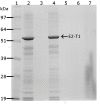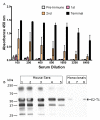Endotoxin-free purification for the isolation of bovine viral diarrhoea virus E2 protein from insoluble inclusion body aggregates
- PMID: 21787435
- PMCID: PMC3160874
- DOI: 10.1186/1475-2859-10-57
Endotoxin-free purification for the isolation of bovine viral diarrhoea virus E2 protein from insoluble inclusion body aggregates
Abstract
Background: Protein expression in Escherichia coli may result in the recombinant protein being expressed as insoluble inclusion bodies. In addition, proteins purified from E. coli contain endotoxins which need to be removed for in vivo applications. The structural protein, E2, from Bovine Viral Diarrhoea Virus (BVDV) is a major immunogenic determinant, and is an ideal candidate as a subunit vaccine. The E2 protein contains 17 cysteine residues creating difficulties in E. coli expression. In this report we outline a procedure for successfully producing soluble and endotoxin-free BVDV E2 protein from inclusion bodies (IB).
Results: The expression of a truncated form of BVDV-E2 protein (E2-T1) in E. coli resulted in predominantly aggregated insoluble IB. Solubilisation of E2-T1 with high purity and stability from IB aggregates was achieved using a strong reducing buffer containing 100 mM Dithiothreitol. Refolding by dialysis into 50 mM Tris (pH 7.0) containing 0.2% Igepal CA630 resulted in a soluble but aggregated protein solution. The novel application of a two-phase extraction of inclusion body preparations with Triton X-114 reduced endotoxin in solubilised E2-T1 to levels suitable for in vivo use without affecting protein yields. Dynamic light scattering analyses showed 37.5% of the protein was monomeric, the remaining comprised of soluble aggregates. Mice immunised with E2-T1 developed a high titre antibody response by ELISA. Western hybridisation analysis showed E2-T1 was recognised by sera from immunised mice and also by several BVDV-E2 polyclonal and monoclonal antibodies.
Conclusion: We have developed a procedure using E. coli to produce soluble E2-T1 protein from IB, and due to their insoluble nature we utilised a novel approach using Triton X-114 to efficiently remove endotoxin. The resultant protein is immunogenic and detectable by BVDV-E2 specific antibodies indicating its usefulness for diagnostic applications and as a subunit vaccine. The optimised E. coli expression system for E2-T1 combined with methodologies for solubilisation, refolding and integrated endotoxin removal presented in this study should prove useful for other vaccine applications.
Figures





Similar articles
-
Expression of the bovine viral diarrhoea virus Osloss p80 protein: its use as ELISA antigen for cattle serum antibody detection.J Gen Virol. 1993 Jul;74 ( Pt 7):1427-31. doi: 10.1099/0022-1317-74-7-1427. J Gen Virol. 1993. PMID: 8393083
-
Evaluation of BVDV E2 proteins based on recombinant baculovirus expression system production as diagnostic antigens and immunogens.Protein Expr Purif. 2025 Feb;226:106611. doi: 10.1016/j.pep.2024.106611. Epub 2024 Sep 22. Protein Expr Purif. 2025. PMID: 39317297 Review.
-
Expression of Bovine Viral Diarrhea Virus Envelope Glycoprotein E2 in Yeast Pichia pastoris and its Application to an ELISA for Detection of BVDV Neutralizing Antibodies in Cattle.J Immunoassay Immunochem. 2015;36(6):639-54. doi: 10.1080/15321819.2015.1032305. J Immunoassay Immunochem. 2015. PMID: 25837831
-
Recombinant Erns-E2 protein vaccine formulated with MF59 and CPG-ODN promotes T cell immunity against bovine viral diarrhea virus infection.Vaccine. 2020 May 8;38(22):3881-3891. doi: 10.1016/j.vaccine.2020.03.020. Epub 2020 Apr 10. Vaccine. 2020. PMID: 32280039
-
Bioprocessing of therapeutic proteins from the inclusion bodies of Escherichia coli.Adv Biochem Eng Biotechnol. 2003;85:43-93. doi: 10.1007/3-540-36466-8_3. Adv Biochem Eng Biotechnol. 2003. PMID: 12930093 Review.
Cited by
-
Screening and identification of genetic loci involved in producing more/denser inclusion bodies in Escherichia coli.Microb Cell Fact. 2013 May 2;12:43. doi: 10.1186/1475-2859-12-43. Microb Cell Fact. 2013. PMID: 23638724 Free PMC article.
-
2-Keto-D-gluconate-yielding membrane-bound D-glucose dehydrogenase from Arthrobacter globiformis C224: purification and characterization.Molecules. 2015 Jan 8;20(1):846-62. doi: 10.3390/molecules20010846. Molecules. 2015. PMID: 25580683 Free PMC article.
-
Effect of active immunization against a recombinant mouse granulocyte-macrophage colony-stimulating factor/somatostatin fusion protein on the growth of mice.Mol Biol Rep. 2012 Jun;39(6):6773-9. doi: 10.1007/s11033-012-1502-6. Epub 2012 Feb 4. Mol Biol Rep. 2012. PMID: 22307789
-
Optimized Triton X-114 assisted lipopolysaccharide (LPS) removal method reveals the immunomodulatory effect of food proteins.PLoS One. 2017 Mar 29;12(3):e0173778. doi: 10.1371/journal.pone.0173778. eCollection 2017. PLoS One. 2017. PMID: 28355240 Free PMC article.
-
Immunogenicity of Outer Membrane Proteins VirB9-1 and VirB9-2, a Novel Nanovaccine against Anaplasma marginale.PLoS One. 2016 Apr 26;11(4):e0154295. doi: 10.1371/journal.pone.0154295. eCollection 2016. PLoS One. 2016. PMID: 27115492 Free PMC article.
References
-
- Thiel HJ, Collett MS, Gould EA, Heinz FX, Houghton M, Meyers G, Purcell RH, Rice CM. In: Virus Taxonomy Eighth Report on the International Committee on the Taxonomy of Viruses. Fauquet CM, Mayo MA, Maniloff J, Desselberger U, Ball LA, editor. Amsterdam: Academic Press; 2005. Family Flaviviridae; pp. 981–998.
Publication types
MeSH terms
Substances
LinkOut - more resources
Full Text Sources
Other Literature Sources

